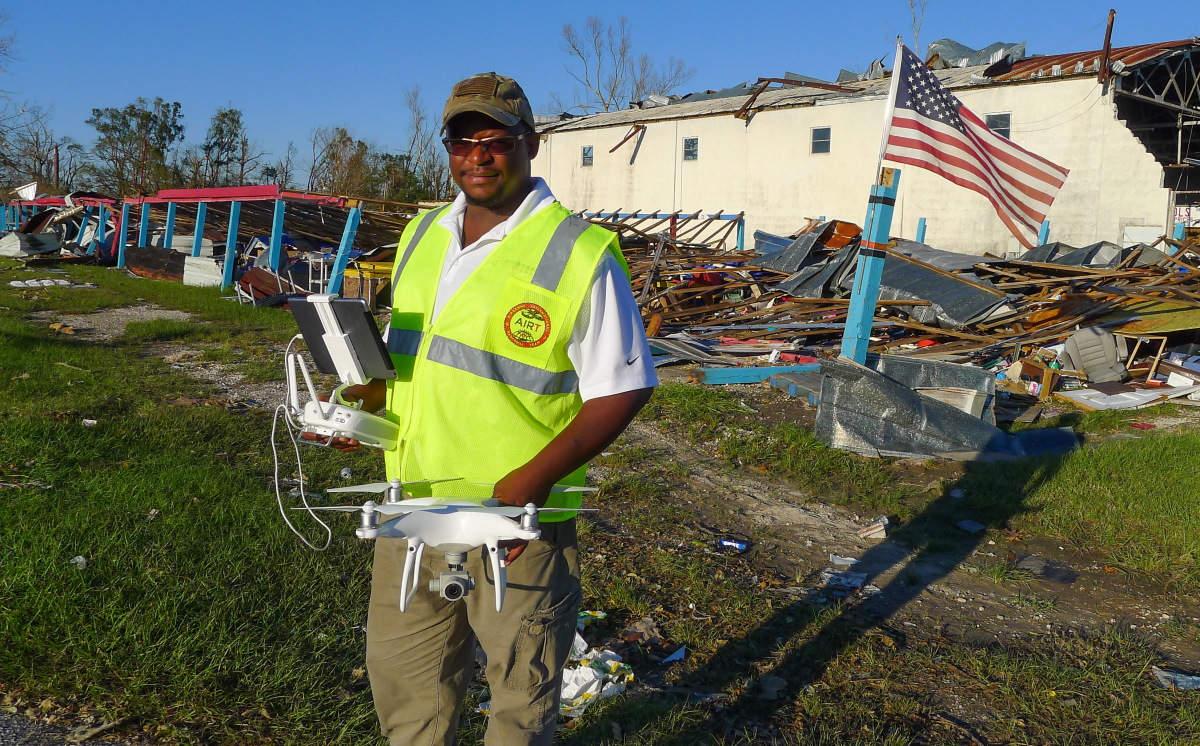
Ty Rozier, a remote pilot with the Airborne International Response Team (AIRT), completes a damage assessment mission in Panama City, Florida in the aftermath of Category 5 Hurricane Michael in October 2018.
By Chloe Williams
Texas Climate News
As Hurricane Dorian approached the United States’ coast, Christopher Todd kept a close eye on the storm. Instead of moving away from its path, however, he was trying to get closer.
Todd is a drone pilot and the executive director of the Airborne International Response Team, a non-governmental organization that provides unmanned aircraft systems for disaster response. He has flown drones in the aftermath of hurricanes Irma, Michael and Dorian.
Flying a drone after a disaster is hard work, he says. Most people assume that operating a drone is as easy as playing video games, but recent research suggests that flying following a disaster is much more taxing than previously thought. The job often involves working extended hours in harsh weather with minimal rest – on various missions Todd has slept in cars, on the ground or in a high school gym. “It’s not a vacation by any means,” he says.
Drones have been used in a slew of climate-related applications in recent years. Scientists have flown drones over prescribed burns to study fire behavior. They have used them to collect atmospheric data, such as wind direction, humidity and levels of infrared radiation, to improve climate models. Drones are not just in the air: Last summer, an unmanned boat sailed around Antarctica, collecting data on the ocean’s acidity to help scientists better understand the Southern Ocean’s role as a carbon sink.
In natural disasters, drones have become an integral tool in response and recovery. In the six days following Hurricane Harvey, the Federal Aviation Administration authorized over 40 drone flights in the Houston area to assist with emergency response. The unmanned robots can aid in search and rescue, map disaster-struck areas and assess damage to critical infrastructure, such as roadways, water plants and power lines. They can scan the landscape more safely, quickly and in more detail than airplanes or helicopters.
Until now, research has largely focused on drones, not pilots, says Ranjana Mehta, associate professor of industrial and systems engineering at Texas A&M University. “People just focused on the technology.” But as unmanned aircraft usage increases, researchers have begun studying what it’s like for the humans operating these machines.
To get a snapshot of the job’s demands, Mehta and her colleagues observed 23 experienced pilots throughout three disasters: hurricanes Harvey and Michael and the Kilauea volcanic eruption. They gauged pilots’ fatigue using a standard test used by NASA and the U.S. military.
Drone crews had elevated levels of fatigue after three days of work, Mehta says. After only two days in the field following Hurricane Harvey, some pilots exhibited levels of fatigue equivalent to a blood alcohol content of 0.05 percent – above the legal limit for airline and helicopter pilots. The results were presented at the International Conference on Applied Human Factors and Ergonomics in July.
The extreme fatigue is not that surprising given the working conditions, Mehta says. After Harvey, pilots were working outside for 12 hours. The environmental conditions can be taxing. “After a hurricane, a lot of the time it’s just humid and hot and nasty,” says Robin Murphy, professor of computer science and engineering at Texas A&M, who was involved in the research. She has piloted drones in 29 disasters, including 9/11 and Hurricane Katrina.
Weather is only one challenge, but there are many others. In a flood, pilots may be standing on a small patch of land, swarmed by insects, Murphy says. They may have to work long, irregular hours. At the Kilauea eruption, crews worked 24-hour shifts.
The problem with pilot fatigue is that it leads to mistakes. In the recent research, pilots made more errors when they were sleep-deprived. And according to prior analyses, about half of robot deployment failures are caused by human errors. In a disaster scenario, mistakes can result in serious consequences, Mehta says. Expensive equipment or critical information could be lost.
A lack of standards is partly to blame for pilots’ high levels of fatigue, Mehta says. Airline pilots are subject to regulations regarding rest schedules and have checklists to guide them through work procedures. Regulations aren’t as clearly defined for drone pilots, says Kathleen Swain, senior director of unmanned aircraft systems programs at the Aircraft Owners and Pilots Association.
The issue of fatigue is well known among the disaster drone community. “We’ve all talked about it,” Murphy says, “but no one had any data.” She and her colleagues hope to continue collecting information on pilot fatigue. Ultimately, they plan on using their research to inform standards for pilot rest schedules, work procedures and training.
Meanwhile, the workload for disaster responders isn’t getting any lighter. Warming oceans are making hurricanes stronger and more destructive, according to climate scientists. Large wildfires have also become more frequent in the past 20 years. And variables related to climate change, such as rainfall and snowmelt, have contributed to an increase in floods.
These changing conditions aren’t affecting drone pilots’ work yet, Murphy says. Even those who fly often are only called out a few times per year. According to Swain, the impact of climate change on drone pilots’ workload will likely depend on how drones are regulated and integrated into emergency response going forward.
Drone usage is still in its infancy, Todd says. “Where the drone industry is right now is kind of like where the internet was back in the 1990s.” Every disaster, he says, is an opportunity to practice and prepare for the future.
+++++
Chloe Williams, a Texas Climate News contributing editor, is an independent journalist who writes about climate change, oceans, energy and health. Her work has appeared in Hakai Magazine, Yale Environment 360, Popular Science and Audubon, among other publications. She is currently based in Alberta, sometimes referred to as the Texas of Canada.
